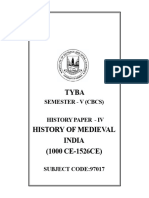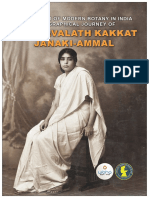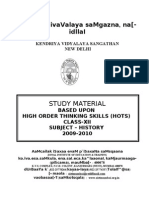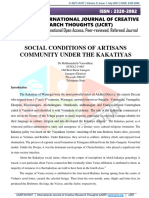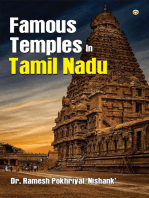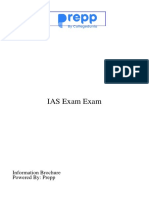0 ratings0% found this document useful (0 votes)
8 viewsLesson 2 - New Kings and Kingdoms Notes
Lesson 2 - New Kings and Kingdoms Notes
Uploaded by
Fathima DeenThe document discusses the emergence of new dynasties in India between the 7th and 12th centuries, including the Rashtrakutas and Cholas. It provides details on how these dynasties gained power and legitimacy, administrative structures, cultural achievements like temple building and irrigation works in the Tamil region, and contrasts 7th century local elections with modern panchayat elections.
Copyright:
© All Rights Reserved
Available Formats
Download as PDF, TXT or read online from Scribd
Lesson 2 - New Kings and Kingdoms Notes
Lesson 2 - New Kings and Kingdoms Notes
Uploaded by
Fathima Deen0 ratings0% found this document useful (0 votes)
8 views3 pagesThe document discusses the emergence of new dynasties in India between the 7th and 12th centuries, including the Rashtrakutas and Cholas. It provides details on how these dynasties gained power and legitimacy, administrative structures, cultural achievements like temple building and irrigation works in the Tamil region, and contrasts 7th century local elections with modern panchayat elections.
Original Description:
Islamic
Original Title
Lesson 2 -new kings and kingdoms notes
Copyright
© © All Rights Reserved
Available Formats
PDF, TXT or read online from Scribd
Share this document
Did you find this document useful?
Is this content inappropriate?
The document discusses the emergence of new dynasties in India between the 7th and 12th centuries, including the Rashtrakutas and Cholas. It provides details on how these dynasties gained power and legitimacy, administrative structures, cultural achievements like temple building and irrigation works in the Tamil region, and contrasts 7th century local elections with modern panchayat elections.
Copyright:
© All Rights Reserved
Available Formats
Download as PDF, TXT or read online from Scribd
Download as pdf or txt
0 ratings0% found this document useful (0 votes)
8 views3 pagesLesson 2 - New Kings and Kingdoms Notes
Lesson 2 - New Kings and Kingdoms Notes
Uploaded by
Fathima DeenThe document discusses the emergence of new dynasties in India between the 7th and 12th centuries, including the Rashtrakutas and Cholas. It provides details on how these dynasties gained power and legitimacy, administrative structures, cultural achievements like temple building and irrigation works in the Tamil region, and contrasts 7th century local elections with modern panchayat elections.
Copyright:
© All Rights Reserved
Available Formats
Download as PDF, TXT or read online from Scribd
Download as pdf or txt
You are on page 1of 3
SUNRISE INTERNATIONAL SCHOOL, ABUDHABI
ACADEMIC YEAR 2023-2024
Chapter 2-New Kings and Kingdoms
Subject: Social Science
Name: Date:
Grade: Teacher’s sign:
LESSON OBJECTIVES:
Students will be able to:
• The emergence of new dynasties.
• How administration was carried out in kingdoms.
• Explain and analyse the tripartite struggle and attacks from invaders
• Appreciate the cultural achievements of the cholas.
Keywords:
Samanta
Temple
Nadu
Sabha
Maharaja-Adhi raja
Prashastis
Sultan
ANSWER THE FOLLOWING:
1.How Did the Rashtrakutas Become Powerful?
Ans. Rashtrakutas were initially subordinate to the Chalukyas of Karnataka.
Dantidurga, a Rashtrakuta chief, vanquished his Chalukya overlord and
performed the Hiranya-Garbha (literally the golden-womb) in the mid-eighth
century. When the ritual was performed with the assistance of Brahmanas, it was
thought to result in the sacrifice's rebirth as a Kshatriya, even if he was not born
as one.
2.What did the new dynasties do to gain acceptance?
Answer: The new dynasties gained power and wealth. Thereafter they declared
themselves to be maha-samantas or mahamandaleshwara. Many of such kings
adopted high sounding titles like maharaja-Adhi raja or Tribhuvana-chakravartin.
They also deputed learned brahmanas to depict them as valiant, victorious
warriors. Their activities were recorded in Prashastis. They tried to demonstrate
their power and resources by building large temples.
3.What Kind of Irrigation Works were Developed in the Tamil Region?
Ans. The areas near the Kaveri River in Tamil Nadu were opened up for large-
scale cultivation in the fifth or sixth centuries. The irrigation works developed in
the Tamil region resulted in the development of water channels for agriculture,
the excavation of wells and tanks for water storage and the construction of
embankments to prevent floods.
4. What were the Activities Associated with Chola Temples?
Ans. Chola temples commonly served as the hubs of settlements that grew
around them. These were centres of craft production also. Chola temples were not
only places of worship, but also economic, social, they were also endowed with
land by rulers and others, and production from the land was used to support all of
the specialists who worked at the temple. Among the temple crafts, the formation
of bronze images became the most distinctive, and these bronze images are still
regarded as the finest in the world. The majority of these bronze images depicted
deities, but some also depicted devotees.
5.Contrast the ‘elections’ in Uttaramerur with present day panchayat
election?
Answer: The system of election in Uttaramerur was quite different from that of
the present day panchayat elections. In the Uttaramerur election, the names of the
persons eligible to be members of the committees were written on small tickets
of palm leaves. The tickets were put into an earthenware pot. Thereafter a young
boy was asked to take out the tickets, one by one for each committee. But the
present day panchayat members are elected through a general election.
6.Look at the map given below and identify and mark those states where new
dynasties emerged during the period of 7th -12th century.
Home work:
7.Think and answer
Find out more about taxes that are collected at present. Are these in cash, kind, or
labour services?
You might also like
- Samskrtasubodhini A Sanskrit Primer M Deshpande 2007 AnswersDocument31 pagesSamskrtasubodhini A Sanskrit Primer M Deshpande 2007 AnswersVenkatraman Srinivasan60% (5)
- Paper 4 History of Medieval India 1000 CE 1526 CE Engilish VersionDocument131 pagesPaper 4 History of Medieval India 1000 CE 1526 CE Engilish VersionPranay BhosaleNo ratings yet
- Rosalind o HanlonDocument40 pagesRosalind o HanlonsiddharthagautamaNo ratings yet
- Kerala Society Structure and Change Edited PDFDocument109 pagesKerala Society Structure and Change Edited PDFShalabha SsNo ratings yet
- Class Vii History CH-2Document4 pagesClass Vii History CH-2shalu.bhadauriya101No ratings yet
- Dibyojit Mukherjee History ProjectDocument37 pagesDibyojit Mukherjee History Projectag8930233507No ratings yet
- Social Studies Module 4 Week 4Document12 pagesSocial Studies Module 4 Week 4shinoamogNo ratings yet
- Craftsmen in Early Medieval Peninsular IndiaDocument36 pagesCraftsmen in Early Medieval Peninsular IndiaPriyanka MokkapatiNo ratings yet
- 8th English Medium Social Science Notes. 2024-25Document40 pages8th English Medium Social Science Notes. 2024-25MCM - MQI College of Management100% (6)
- Component-I (A) - Personal Details:: Prof. P. Bhaskar Reddy Sri Venkateswara University, TirupatiDocument7 pagesComponent-I (A) - Personal Details:: Prof. P. Bhaskar Reddy Sri Venkateswara University, TirupatiSaksham GuptaNo ratings yet
- Re-Reading Caste and Gender A Study of The Rituals of Kodungallur Sri Kurumba Bhagavathy Temple of KeralaDocument5 pagesRe-Reading Caste and Gender A Study of The Rituals of Kodungallur Sri Kurumba Bhagavathy Temple of KeralaEditor IJTSRD100% (1)
- AK CN Grade+6 Social+Science Chapter+7 Class+2Document10 pagesAK CN Grade+6 Social+Science Chapter+7 Class+2Kirti MahajanNo ratings yet
- Manikkavacakar & BiographyDocument8 pagesManikkavacakar & BiographyEverything newNo ratings yet
- Teachers Guidelines - ModuleDocument15 pagesTeachers Guidelines - ModulepinkypinkyponkyNo ratings yet
- Std-Vii-Rise of Small Kingdoms in South India (Notes)Document5 pagesStd-Vii-Rise of Small Kingdoms in South India (Notes)niel100% (2)
- Hisotryy L-2Document3 pagesHisotryy L-2iamchad43No ratings yet
- HistoryDocument7 pagesHistoryAnkem AdityaNo ratings yet
- Dr. E. K. Janaki Ammal - EngDocument31 pagesDr. E. K. Janaki Ammal - Engnanu aroraNo ratings yet
- Class 7 History Chapter 2 New Kings KingdomsDocument3 pagesClass 7 History Chapter 2 New Kings KingdomsPrincipal SSIT, G'nagarNo ratings yet
- 270424110159File7TH SOCIAL STUDIES FA-2Document15 pages270424110159File7TH SOCIAL STUDIES FA-2famkmr11No ratings yet
- Study Material - Hots Questions History 2009-10Document17 pagesStudy Material - Hots Questions History 2009-10Sharvesh KunwarNo ratings yet
- Unit - 10 Higher EducationDocument195 pagesUnit - 10 Higher Educationm.reddysekhar9No ratings yet
- Ancient VaastuDocument35 pagesAncient VaastuKusumapriya007No ratings yet
- 12 History Ncert Ch02Document6 pages12 History Ncert Ch02manpreet kaurNo ratings yet
- Mysteries and More BorobudurDocument172 pagesMysteries and More BorobudurUday DokrasNo ratings yet
- TG History Answers emDocument9 pagesTG History Answers emPranoy KumarNo ratings yet
- Topic: The Vedic Age: Dps International School Subject History Worksheet NoDocument4 pagesTopic: The Vedic Age: Dps International School Subject History Worksheet NoNaman PahujaNo ratings yet
- Unit 10 - Higher Education SystemDocument56 pagesUnit 10 - Higher Education SystemAbhishek Dali100% (2)
- Notes Gupta To Maurya Empires NewDocument2 pagesNotes Gupta To Maurya Empires NewAyesha SyedNo ratings yet
- Answers of Ancient and Medieval HistoryDocument34 pagesAnswers of Ancient and Medieval Historygauravthoke19No ratings yet
- Class - 7 - Ch-10.The Rise of Small Kingdoms inDocument13 pagesClass - 7 - Ch-10.The Rise of Small Kingdoms iniammonikadeswalNo ratings yet
- IJCRT2107457Document11 pagesIJCRT2107457Samrat PvNo ratings yet
- Class6.HistoryLessonNo.9Q&A.. 0Document3 pagesClass6.HistoryLessonNo.9Q&A.. 0Ranjana PandeyNo ratings yet
- WWW - Learncbse.inimportant Questions For Class 12 History Chapter 2Document23 pagesWWW - Learncbse.inimportant Questions For Class 12 History Chapter 2anjalisingh93688No ratings yet
- Iq History Chapter 2Document18 pagesIq History Chapter 2anjalisingh93688No ratings yet
- Chapter 8 Aspects of Culture in Ancient IndiaDocument2 pagesChapter 8 Aspects of Culture in Ancient IndiaJaisnava GhoshNo ratings yet
- AsaDocument20 pagesAsaHafiz SajjadNo ratings yet
- History ProjectDocument30 pagesHistory ProjectMansi TiwariNo ratings yet
- Reviewing Classic Reading: A Study On Kautilya's Arthashastra'Document49 pagesReviewing Classic Reading: A Study On Kautilya's Arthashastra'Mirza ArnabNo ratings yet
- 12 History Ncert Ch02Document7 pages12 History Ncert Ch02manpreet kaurNo ratings yet
- MDC 1 3 Indian HistoryDocument3 pagesMDC 1 3 Indian Historyshibabhati301No ratings yet
- 5 Year Integrated SyllabusDocument34 pages5 Year Integrated SyllabusmaribardNo ratings yet
- 10 - Chapter 2 PDFDocument32 pages10 - Chapter 2 PDFAto TheunuoNo ratings yet
- Art Culture Religious Aspectsof Medieval IndiaDocument7 pagesArt Culture Religious Aspectsof Medieval Indiabalmukundsinghbisen15122001No ratings yet
- Synopsis by Sonali PriyadarsaniDocument5 pagesSynopsis by Sonali PriyadarsaniSonali DalaiNo ratings yet
- Ehi 3 emDocument8 pagesEhi 3 emFirdosh KhanNo ratings yet
- Kon Ark Sun TempleDocument12 pagesKon Ark Sun TempleShrikant SomanNo ratings yet
- CBSE Class 7 Social Science Our Past 2 Chapter 2 New Kings and Kingdoms Important Questions 2023-24Document8 pagesCBSE Class 7 Social Science Our Past 2 Chapter 2 New Kings and Kingdoms Important Questions 2023-24Gamers For Life . comNo ratings yet
- 2804191115423823Document9 pages2804191115423823krishan50% (2)
- Later Vedic PeriodDocument3 pagesLater Vedic PeriodAll GamerNo ratings yet
- Damodaram Sanjivayya National Law University Visakhapatnam, Andhra PradeshDocument41 pagesDamodaram Sanjivayya National Law University Visakhapatnam, Andhra Pradeshsarayu alluNo ratings yet
- Std11-RASHTRAKUTISH, CHALUKYAS EMDocument7 pagesStd11-RASHTRAKUTISH, CHALUKYAS EMshaliniNo ratings yet
- 5f2411ee5fb0e20200731124326PG CC7 - THE ANCIENT UNIVERSITY OF VIKRAMSHILA - PART 1 - DR MD NEYAZ HUSSAINDocument10 pages5f2411ee5fb0e20200731124326PG CC7 - THE ANCIENT UNIVERSITY OF VIKRAMSHILA - PART 1 - DR MD NEYAZ HUSSAINAashutosh RajadhyaxNo ratings yet
- 11.Dr. Veena Devi Trivedi3Document7 pages11.Dr. Veena Devi Trivedi3INTERNATIONAL JOURNAL FOR EDUCATIONAL RESEARCH STUDIESNo ratings yet
- Social Science: Standard IxDocument282 pagesSocial Science: Standard IxKalaiselvan ChinnaiyanNo ratings yet
- Marriage and Rank in Bengali Culture: A History of Caste and Clan in Middle-Period BengalFrom EverandMarriage and Rank in Bengali Culture: A History of Caste and Clan in Middle-Period BengalNo ratings yet
- The Crescent Arises over the Banyan Tree: A Study of the Muhammadiyah Movement in a Central Javanese Town, c.1910s-2010 (Second Enlarged Edition)From EverandThe Crescent Arises over the Banyan Tree: A Study of the Muhammadiyah Movement in a Central Javanese Town, c.1910s-2010 (Second Enlarged Edition)No ratings yet
- Hindu Rulers, Muslim Subjects: Islam, Rights, and the History of KashmirFrom EverandHindu Rulers, Muslim Subjects: Islam, Rights, and the History of KashmirRating: 5 out of 5 stars5/5 (1)
- Precarious Balance: Sinhala Buddhism and the Forces of PluralismFrom EverandPrecarious Balance: Sinhala Buddhism and the Forces of PluralismNo ratings yet
- Famous Temples in Tamil NaduFrom EverandFamous Temples in Tamil NaduRating: 5 out of 5 stars5/5 (1)
- Perspectiva Ayurvedica Sobre Ciclo MenstrualDocument6 pagesPerspectiva Ayurvedica Sobre Ciclo MenstrualRGuti13No ratings yet
- Arya Samaj PDFDocument5 pagesArya Samaj PDFAastha ShrivastavaNo ratings yet
- Page and Katarina Hero Cycle Tracking Chart 2022Document9 pagesPage and Katarina Hero Cycle Tracking Chart 2022api-669262956No ratings yet
- 21st Indian LiteratureDocument43 pages21st Indian LiteratureJOLLIBEE TORRESNo ratings yet
- Toaz - Info Prat Yang Ira PRDocument33 pagesToaz - Info Prat Yang Ira PRprabhaNo ratings yet
- Kalai - B15Document45 pagesKalai - B15KALAINo ratings yet
- Anchoring Script For Independence DayDocument4 pagesAnchoring Script For Independence Dayratika100% (1)
- Bhima Bhoi The Philosopher PoetDocument3 pagesBhima Bhoi The Philosopher PoetEditor IJTSRDNo ratings yet
- The Thirteen Miracles of Bala During The Nine Auspicious Days of NavarathriDocument64 pagesThe Thirteen Miracles of Bala During The Nine Auspicious Days of NavarathriSHIV RAMNo ratings yet
- KBPE Class 7 Social Science Part 2 TextbooksDocument80 pagesKBPE Class 7 Social Science Part 2 Textbookssitara42876786No ratings yet
- The Shabd Yoga TechniqueDocument24 pagesThe Shabd Yoga Techniquelestor999No ratings yet
- Sri Skanda Puranam - Sankara Samhita Part1Document697 pagesSri Skanda Puranam - Sankara Samhita Part1Sivason100% (3)
- Kashmir Travel GuideDocument9 pagesKashmir Travel GuideKapil ShereNo ratings yet
- Dashashloki (With Introduction and Translation)Document4 pagesDashashloki (With Introduction and Translation)praviprolu100% (1)
- Dhivan Positive NidanasDocument25 pagesDhivan Positive Nidanasrobertmckeon4027No ratings yet
- 21 TarasDocument19 pages21 TarasKatherina FominaNo ratings yet
- Name Numerology 01Document11 pagesName Numerology 01Manoj Vashishth100% (1)
- Thanjavur Big TempleDocument26 pagesThanjavur Big Templebipashakarmakar990No ratings yet
- Unit 2Document6 pagesUnit 2ASHNo ratings yet
- The Vijayanagar and Bahamani KingdomDocument8 pagesThe Vijayanagar and Bahamani KingdomVarun RyderNo ratings yet
- Shrikshetra A Replica of Indian Culture: SrimandiraDocument4 pagesShrikshetra A Replica of Indian Culture: SrimandiraSK SahooNo ratings yet
- UtsavsDocument3 pagesUtsavsNikiel RamawtharNo ratings yet
- Devi Kesadi Pada VarnanamDocument8 pagesDevi Kesadi Pada Varnanamkrishvidhya2000No ratings yet
- Turya-Course IntroductionDocument2 pagesTurya-Course Introductionpankaj rajputNo ratings yet
- SadhanaDocument11 pagesSadhanasadhubabaNo ratings yet
- Lesson 14 - Ante Narayana SmritiDocument3 pagesLesson 14 - Ante Narayana SmritiS KNo ratings yet
- Devi Narayaneeyam - Dasakam 28 Sakthyavamana Dosham-The Sin of Insulting The SakthiDocument12 pagesDevi Narayaneeyam - Dasakam 28 Sakthyavamana Dosham-The Sin of Insulting The SakthibrindaNo ratings yet
- Trimsamsa D-30 Chart: Element Planet State Tithi DaysDocument4 pagesTrimsamsa D-30 Chart: Element Planet State Tithi DaysMatthew CornilleNo ratings yet
- Untitled 1Document2 pagesUntitled 1PSGNo ratings yet

